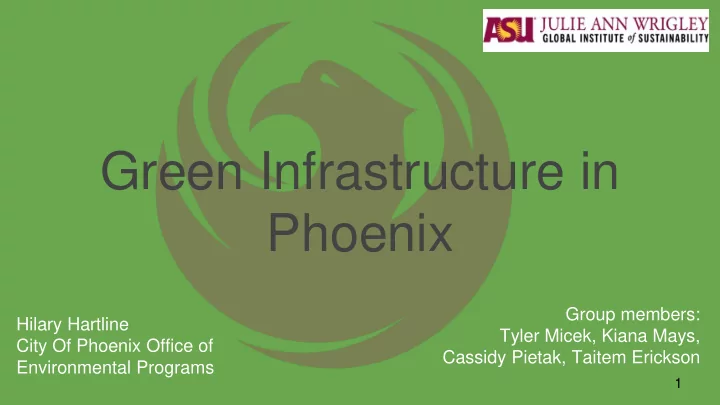

Green Infrastructure in Phoenix Group members: Hilary Hartline Tyler Micek, Kiana Mays, City Of Phoenix Office of Cassidy Pietak, Taitem Erickson Environmental Programs 1
Problem: Stormwater in Phoenix High amount of impervious surfaces High stormwater accumulation Water and soil pollution Grey infrastructure systems fail Objectives Identify functionality of specific GI over lifetime Initial and Operating costs for GI over lifetime Find direct and indirect benefits of GI 2
Reduced/Disconnected Impervious Surfaces ● practice used to minimize impervious surface area, or direct stormwater to reduce the volume of runoff ● Implements multiple GI features ● Applicable on rooftops or on-lot residential areas 3
Permeable Pavements Stabilized aggregate Permeable Pavers Porous Concrete Porous Asphalt Porous Asphalt 4
Challenges of Permeable Pavement City Code 32-33 E.3. All sidewalks are required to be surfaced with Portland Cement material. Amend Subdivision ordinance to allow use of permeable pavement for sidewalks. It is more expensive to install as compared to traditional pavements. The maintenance requirements of permeable pavement are quite different. They aren’t as strong as traditional or asphalt pavements. 5
Traffic Chicanes ● Traffic calming feature designed to slow traffic while enabling GI benefits. ● “Bump outs” or curb extensions along side streets ● includes a bioretention area with vegetation that captures storm-water runoff ● substitute for traditional speed bumps ● multiple positive externalities ● encourages alternative transportation 6
Challenges and Benefits of Traffic Chicanes Benefits: - reduced impervious pavement, creates new areas for landscaping increased pedestrian safety, improves street aesthetics, creates shade and cooling effects for pedestrians, encourages alternative methods of transportation Challenges: - price - average $6,690, may require removal of on street parking - when compared to the price of a traditional speed bump, traffic chicanes offer a better alternative with additional benefits 7 - City coding
Curb Cuts Enables stormwater to enter a landscaped area Reduces peak/total runoff into stormwater systems Less expensive than traditional raised curbs Less material used in making of curb Maintenance: clear debris/sediment accumulation in curb cut (1-2 times/year) Repair/reinforce erosion damage (annual inspection/after major storms) Functions best in lower areas; implemented with bioretention basins, vegetated swales, Barriers: City Code Zoning 507 Tab A etc. 8 Indirect Benefits: heat-island reduction, aesthetics, wildlife habitat
Bioretention Basins 9
Costs Benefits Challenges - Capital Costs: - City building codes and - Reduces runoff $53,000/hectare ordinances - Can size to almost any - (less than $1 per sq. foot) scale - Maintenance per year: - Infiltrates pollutants $5000 - Aesthetic value - Fits most landscapes - Relatively low maintenance costs 10
Vegetative Swales - Process - Design - Scale - Relevance San Diego, CA 11
Costs Benefits Challenges - Capital Costs: - Requires a lot of space - Diverts stormwater $30,000/hectare runoff - Maintenance costs - Maintenance per year: $200 - City Code Zoning 507 per 900 sq. foot area - Dangerous to use in Tab A Guidelines for industrial areas - Higher estimated costs if Design Review - Thick vegetative cover is improperly implemented/ - Reduce Urban heat needed for highest managed island effect effectiveness - Raise property value - No current template for Phoenix Manning’s equation - 12 - n=0.25
Our Recommendation for the City of Phoenix: It is possible to utilize the natural ecology of the Phoenix area to improve stormwater diversion efforts. By implementing green infrastructure as well as incentivizing the implementation of green infrastructure to private contractors, business owners, and residential communities, it is very possible to raise the functionality of the stormwater system. While it would be costly to transform much of the existing infrastructure in Phoenix, there would be a trade-off in the money saved in maintaining these forms of storm water diversion. Proposal: Sky Harbor Airport pitch 13
Questions? 14
References 1. https://www.epa.gov/sites/production/files/2015-10/documents/phoenix_gi_evaluation.pdf 2. http://mesaaz.gov/home/showdocument?id=14999. 3. http://www.saveitlancaster.com/wp-content/uploads/2011/10/09_VegSwale_V3.pdf 4. http://www.lakesuperiorstreams.org/stormwater/toolkit/bioretention.html 5. http://sandiegodowntownnews.com/art-on-the-land-making-a-first-and-lasting-impression/ 6. http://www.azdhs.gov/documents/preparedness/epidemiology-disease-control/extreme-weather/heat/heat-map22.pdf 7. http://www.sandiegocounty.gov/dplu/docs/081024/TM5499-SWMP-A.pdf 15
Recommend
More recommend